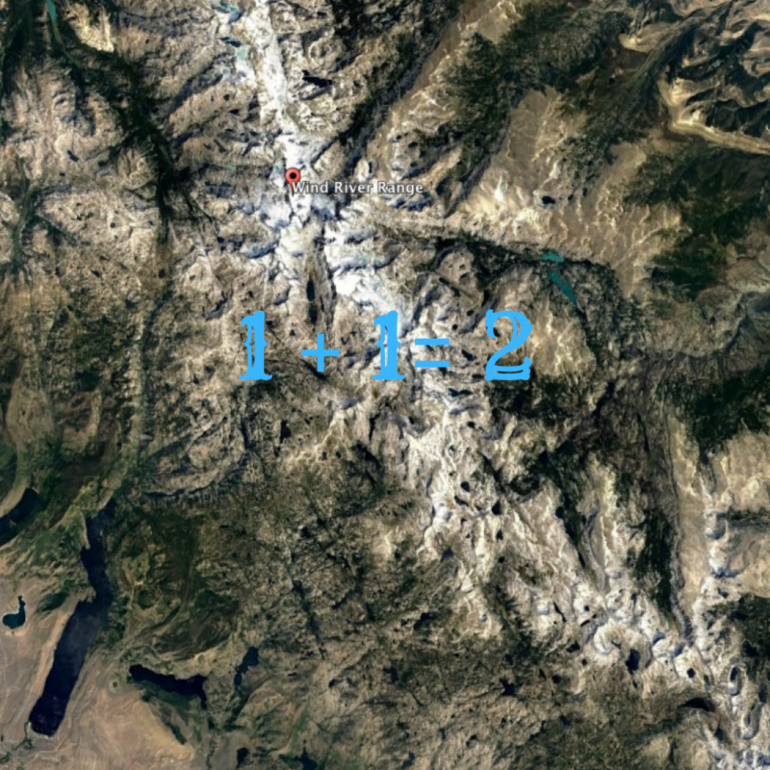
Three personalities, one trip, one end goal: we all come home safe and friends. That’s the baseline.
We’re planning a Winds traverse 2.0. Last year, after weather window watching for two months, we finally jumped headfirst into a four-day window that slammed shut on day three. We audibled on route selection and came home safe and friends. This was mid-May and we hadn’t even considered bringing XTRATUFs which may have assisted with the scary-thawing-lake crossings as we scurried toward Pinedale.
For an excellent trip report written by a burly packrafter/skier we met on our retreat click here. This group was heading in, we were heading out.
In an attempt to keep word count tight: We had a scare on that third day, a full-body drenching with some spicy lightning bolts from the weather gods while descending into Titcomb Basin. We brought an MSR Front Range mid (pyramid & floorless shelter) at 910g, lightweight air mattresses, and approx. 15-degree sleeping bags. This story is about shelters, though, what to bring, and not so much sleep systems.
Ok: word count tightness, I’m losing that battle.
Here’s what we found with the mid. And this experience comes after years of using mids, mostly the original Black Diamond MegaMid, which I still own and love, but settles in at 1312g, and add on another 308g if you bring the single center pole. The context is we are not the youngsters we might imagine ourselves. We’ve slowed a bit, and sleep more restless than we have in the past. Which means we are slower to recover. And on a long push, these attributes are on our minds. Mostly the recovery piece.
Post-trip assessment last spring, we were adamant: no-mid, we’ll bring a single wall, alpinism style “assault” tent. We felt too caught out in the storm we had experienced and kind of felt like we got away with something. Also duly noted, Brian, trip 1.0 partner, spent this winter watching 60 kt winds blow spindrift off the ridges from his kitchen window. He has previous experiences in the Winds with 4-season tents snapping poles and bowing so low as to contemplate being suffocated by the tent ceiling. All this has us seriously exploring alternative options for domicile on this trip. Know this comes from a place of softness. Hardman status, if that’s still a thing, is not something our group codifies. Yet, one in this year’s group of three, Kelly, is a legit sufferer, though he insists he’s a reformed sufferer. So in a way, I hope he is our talisman of sorts, on our path forward for trip 2.0.
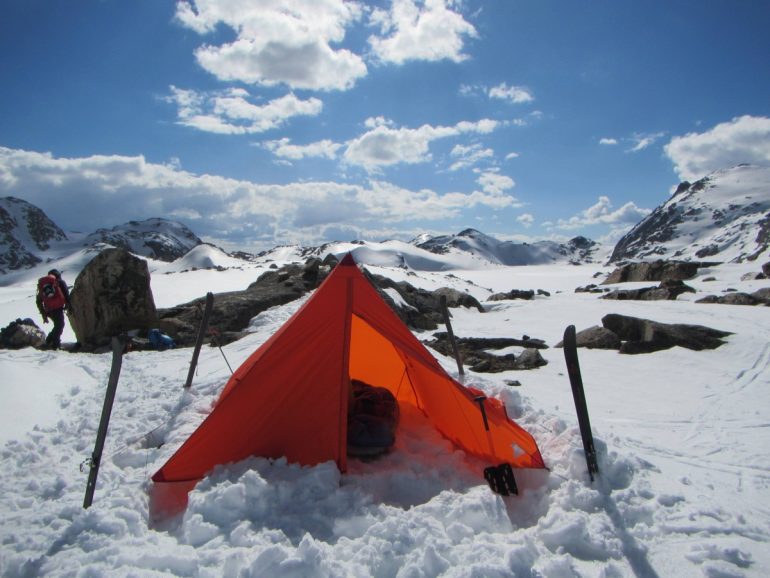
The MSR Front Range mid providing shelter and shade on a sunny Wind River day. Trip 1.0.
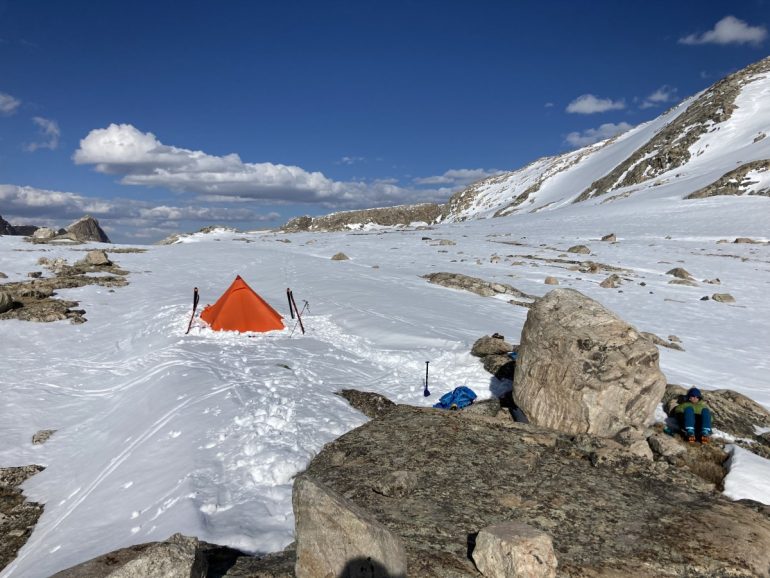
A tidy mid in the Winds.
What we assessed with the mid:
— Longer setup to tension out the mid with skis, poles, etc.
— Longer time shoveling and crafting a flat area and weatherproofing costs energy.
— Even more shoveling and crafting snow to ensure a tidy sleep area for three. The last trip, with two participants, the Front Range was just enough room for two and our yard-saled gear.
—I slept cold. I wore pretty much everything while I sort of slept. The mid excelled on day three when we stripped down to underwear and burned extra fuel to warm up and dry off. There was ample opportunity to create makeshift interior clotheslines. I’m a little shocked the mid failed to achieve liftoff and blow toward the high-steppes way way way to the southeast during the storm.
The caveat is I know mids remain a viable shelter go-to. A group of hearty youngsters just finished the Bugaboos to Rodgers pass Traverse (Simi Hamilton, Linden Mallory, and Ben Koons). They used a mid to good effect. Notes for mid-happiness from Hamilton include the following; Throwing in a few shelves is super nice; Undercut the sides to give yourself even more floor area; Throw empty packs down in the foot trench so that you can kick your boots off and rest your feet on something warm and dry.
He says the finely sculpted mid/penthouse featured in the photo below took roughly 20 minutes to craft. I’m doing the rough math in my head (yes! both the new and old math) to equate their time to build out a suitable shelter to our team’s likely time-warp. Conservatively, it would take maybe 45 minutes for us to complete a similar design with a solid effort; I’m guessing likely an hour.
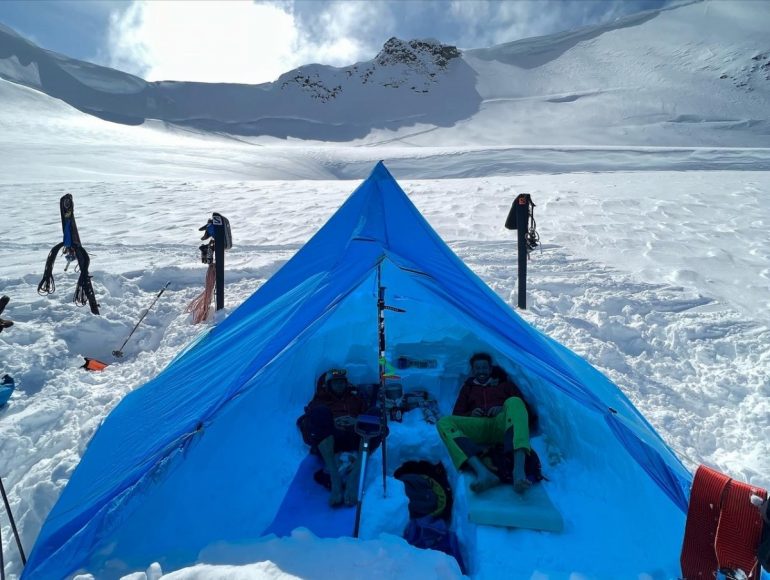
The craftsmanship is impeccable: A lovely mid hideaway for Simi Hamilton, Linden Mallory, and Ben Koons along the Bugaboos to Rodgers Pass Traverse.
***
(Below is the section about our shelter plans for our trip. I’ll have to call and consult my partners again, Hamilton gave a pretty solid pitch for going with a mid.)
Moving forward, here’s the plan, and I imagine the gram-counters (which Kelly is knee-deep as an unprofessional gram-counting actuary) might shun us.
Here’s a text from Kelly (slightly edited) to fill you in on the premise:
“I’ve been doing some calculations on sleep setups, too, and am kinda thinking that maybe 2 x 2 First Lights — which I think you already suggested — might be the ticket? We can rotate who sleeps solo, or if someone sleeps cold (you-Jason) they always get the one with two people in there (much warmer!). Put the doors facing each other and cook in the middle or something. I have a wicked light little tarp (4oz) I made with some light nylon. I was thinking of bringing it anyway — can fashion a little sun-shelter lean-to during breaks, or use for wind cover etc. We could also use it to cover our packs/gear outside the tents, or just pile the extra gear into the tent with one person. I have a 2p FL. Do you or Brian have one also? If only tent+poles (no stakes, strings, bags; use our skis, rocks, buried stuff sacks, and ski poles instead), my FL = 44.8oz. This idea (2 x 2 + my little tarp) weighs 5#14oz.
Another option is buy or borrow the 3p FL and puppy pile in there for a week straight. Would be warm and lighter. Not as much space as the 2 x 2 idea, but weighs 4#2oz (incl tarp in all these weights) — so lighter by nearly 2#.
I have an UL bivy sack (6oz), it’s roomy and with the tarp strung over it in an A-frame it might not be a bad solo sleep setup. If doing the 3p FL + bivy sack, some nights someone sleeps there (I’d prob be fine doing this, I sorta like it). If it’s seeming like a colder night, we all pile in the 3p. If did a 3p FL + the bivy sac, it’s 4#8oz, which is still ~1.5# lighter than the 2 x 2 option.
Then again, if we like the flexibility options afforded by the 2 x 2 FL idea, the weight penalty is less than a pound each over the FL 3p options. Hmmm.”
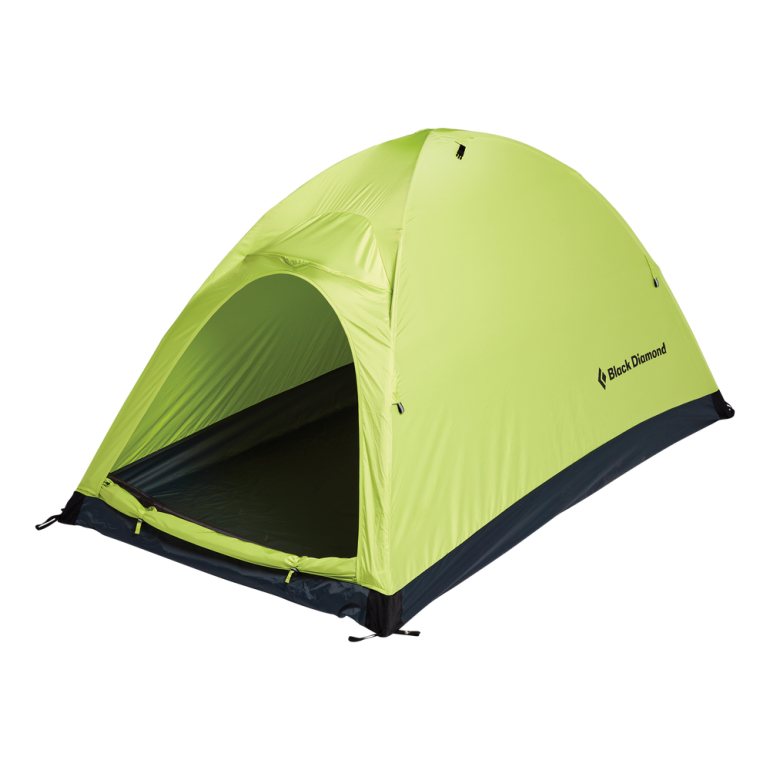
The BD 2P FirstLight. Light, easy to pitch, close confines, single walled. Photo: Black Diamond.
After some discussion, and already having 2 x 2P FirstLights in hand, we are going with the two-tent system.
The basic weights one more time.
— 2p FirstLight (Kelly’s tent sans lines, stakes, stuff sacks): 1254g (2 x = 2508g)
— 3p FirstLight: 1745g
— MSR Front Range mid: 910g
— Kelly’s minimalist tarp: 113g
— Kelly’s UL bivy sack: 170g
Our pre-trip assessment considered this:
— Hope to sleep warmer and better in the tents. (We are worried about recovery on this six-day trip. We’re old. Especially me and Kelly.) Honestly, they are tight tents. If you like your space, the 2P FirstLight is about perfect for one.
— Quicker overall setup time. Quicker tent deployment if the weather gods choose to smack down our hubris. These tents feature two internal poles that are easy to set up. We have the choice of tensioning out if we bring guy lines.
— Hope sleep climate and shorter setup time help recovery despite carrying more sleep-system weight overall.
— Yes, heavier overall. According to Kelly’s calculations, the 2 x FL tents and tarp are 2621g (5 pounds 14oz). The single 3P FL + tarp + UL bivy is 2177g (4 pounds 8oz.). The 3p FL tent is 1745 g (3 lb 14oz), and we would have to borrow this tent and likely explain how Tenacious Tape covering the holes we created is just as good as the original material.
We’ve decided that, calorically and mentally, dividing the extra weight of roughly two pounds between the three of us might cost less in the end. Less digging in the snow, more time to sleep. It’s the “new math” – otherwise known as the Common Core standards. As the saying goes, you can’t put a price on morale.
(Thanks to Brian Parker and Kelly Cordes for the help.)
Jason Albert comes to WildSnow from Bend, Oregon. After growing up on the East Coast, he migrated from Montana to Colorado and settled in Oregon. Simple pleasures are quiet and long days touring. His gray hair might stem from his first Grand Traverse in 2000 when rented leather boots and 210cm skis were not the speed weapons he had hoped for. Jason survived the transition from free-heel kool-aid drinker to faster and lighter (think AT), and safer, are better.
